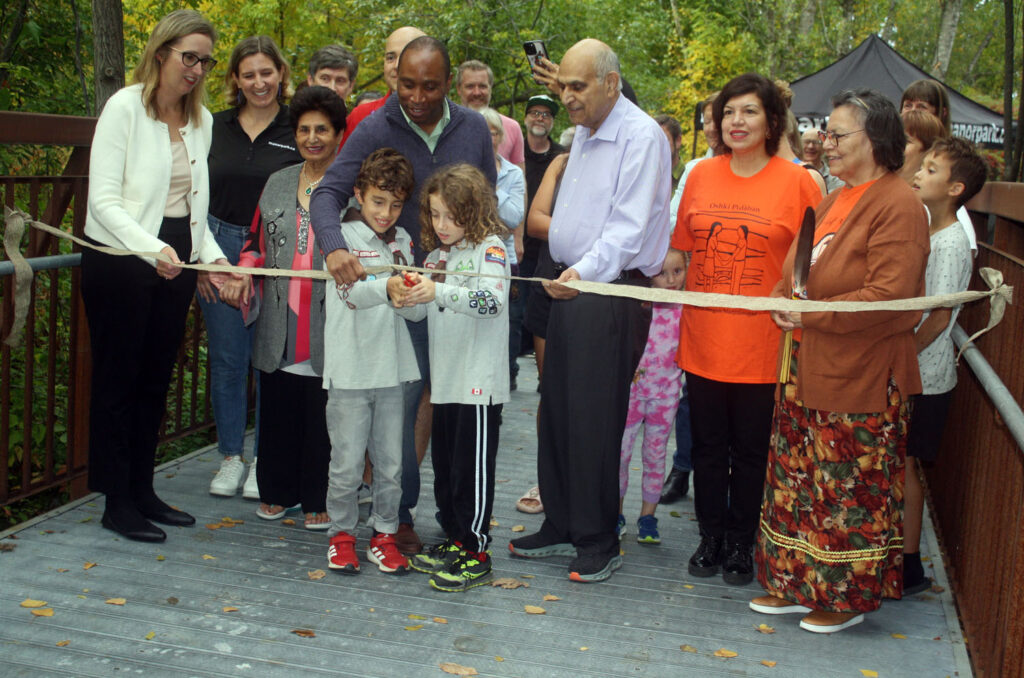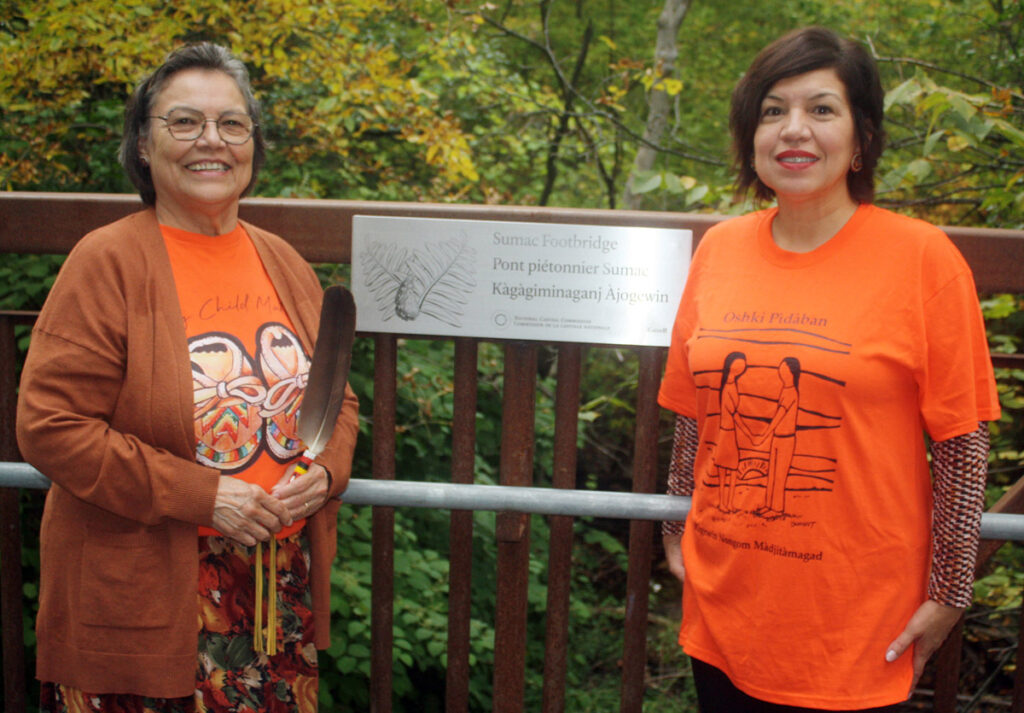Community comes together for Sumac Footbridge commemoration
Algonquin First Nations plays key role in structure’s naming

The ‘new’ walking bridge has been in place at the east end of Blasdell Avenue since 2022. Already it has catered to countless pedestrians, cyclists, and running enthusiasts in Manor Park.
And after the adjoining, paved pathway was completed by the National Capital Commission (NCC) this summer, the stage was set for a commemoration. That special ceremony took place on the evening of Tuesday, Sept. 23.
Under ideal early fall skies, the picturesque ‘Sumac Footbridge’ — linking Blasdell Avenue to the Capital Pathway trail network — was officially unveiled.
The event attracted dozens of residents, officials and stakeholders. It opened with words from Anita Tenasco, a member of Kitigan Zibi, an Algonquin First Nation north of Ottawa. She, along with her mother Jenny, a residential school survivor, performed a smudging of the bridge. This is a traditional act to cleanse the steel structure of any negative energy.
“When we do this, it’s like we’re welcoming all to this space and we’re honouring this beautiful structure,” Tenasco told the crowd.
Jenny then shared a prayer in the Anishinaabemowin language.
Naming process

Manor Park Community Council naming committee member Kelsey McMahon explained how the name was determined.
After being gifted the naming rights by the bridge’s anonymous donors, the committee sought submissions from the public. The committee — which included Anthony Di Carlo and Megan Underwood — received 50 suggested names in response.
“It was really exciting to see the passion of the community,” McMahon said.
The committee also consulted with Elders and Knowledge Keepers from Kitigan Zibi. Together with the NCC, they landed on ‘Sumac Footbridge’.
“We chose that name as an homage to the forest surrounding the bridge … as well as for the Sumac’s relevance and significance to Indigenous culture,” McMahon said.
Tenasco said the elders had many questions for the committee — where the bridge is located, who would use it, what it would connect to — among others.
“Once we got through those questions, we talked about the land surrounding this community and the bridge, and that’s really what inspired the name,” she said.
The plaque affixed to the bridge features three languages — English, French and Algonquin (Kàgàgiminaganj Àjogewin).
“Community members and elders were very happy when our language and Sumac was selected for the name of the bridge. Even ‘Àjogewin’, the word for footbridge in our language, was selected to be included.”
Thanks all round
Émilie Girard-Ruel is Director, Public and Corporate Affairs with the NCC. She thanked all involved in bringing this project to fruition.
“We’re so very grateful to everyone who contributed to making this happen,” she said.
“It’s very significant that the community worked with Kitigan Zibi, have a name that has deep meaning for them and that the language is also present.”
Rideau-Rockcliffe Councillor Rawlson King echoed those sentiments.
“It’s important for us to always recognize that we are on the unceded territory of the Algonquin Anishinabeg people who have been the traditional custodians of this land since time immemorial,” he said.
After thanking the community as a whole “for their advocacy and hard work,” King said it was “really joyful to be standing on this bridge.”
The councillor used the bridge as an analogy for building stronger communities. “This is necessary infrastructure that is definitely required to link our communities together.”
Manor Park Community Association president Natalie Belovic said the bridge has already been getting plenty of use. It just adds to the “pretty magical place” Manor Park is for people to live and play.
Truth and Reconciliation
Tenasco, who is the Director of Indigenous Initiatives at Algonquin College, said she would promote the bridge to the more than 1,100 Indigenous students at the school.
“Many of them do … explore different parts of this beautiful city that we share with everyone,” she said.
“True reconciliation is building partnerships, having communication, getting to know one another and building trust. And a project like this is one step in that important work,” Tenasco told the crowd. “For residential school survivors, to be a part of these types of events, to see our work come to life and language to be present, that’s truly meaningful, that’s very powerful.
So, I say, Miigwech (thank you).”
Following the ceremony, Manor Park resident Marie-Claude Quessey was on hand to discuss all things Sumac with attendees.



